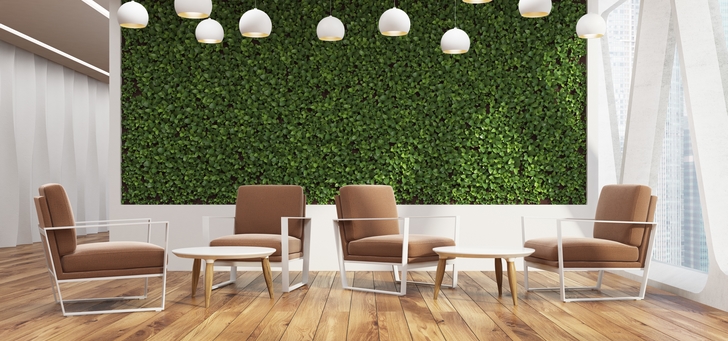Biophilic design: 14 main concepts to use to reinvent indoor landscaping!
Biophilic design is a new territory to explore for landscape designers who wants to reinvent indoor spaces!

Landscaping is not the prerogative of outdoor spaces! For a long time, Architecture has used the virtues of nature indoors. And interest is growing for biophilic designs in all kinds of buildings, in particular in companies in which employee wellbeing is a real issue. Landscape designers have a new territory in which to deploy their talents, and what is interesting is that the main concepts of biophilic design have already been codified for indoor landscaping. All you have to do is apply them!

From biophilia to biophilic design…
The word biophilia designates the innate connection between humans and nature. From this instinctive need stems, since Antiquity, the omnipresent representation of nature in buildings and which continues today. Naturally, biophilia has a niche in modern architecture through biophilic design… and contributes to the growth of indoor landscaping!
An ideal response to current demands
For centuries, the many benefits nature has on human beings have been recognized and used. During the massive urbanization in the 19th century, the creation of public parks became a way of protecting public health and boosting the wellbeing of townspeople (1). These benefits have led to, for example, the creation of hospitals with views onto nature and the design of therapeutic gardens.
Biophilic design integrated into an indoor space:
- reduces stress;
- supports community cohesion;
- optimizes cognitive capacities;
- improves creativity;
- and, due to all this, boosts productivity.
Companies with happy employees are less likely to be affected by sick leave - and contact interior landscape designers increasingly frequently! Any building handling the public (schools, tourism structures…) as well as private homes are also impacted by the biophilia trend.
Read also: 4 mad ecological town planning projects you should know about
The 14 main biophilic design concepts
At a workshop organized by EILO (European Interior Landscaping Organisation), Interior Architect Oliver Heath listed the models on which biophilic design is based. These concepts, focused on the interaction between architecture, nature and human biology, are separated into 3 distinct groups.
Check out the full presentation of the 14 concepts on which biophilic design is based!
The direct inclusion of nature inside indoor spaces
Biophilic design should create multisensorial interactions by physically integrating nature in a space in a host of ways – plants, water, animals, scents, light…
- Visible link with nature: establishing a view over living systems.
- Invisible link with nature: using sounds, perfumes, taste or tactile stimulations.
- Non-rhythmic sensory stimulations: creating random and transitory effects from unprogrammed natural elements.
- Thermal variability and air renewal: creating natural conditions is essential to control relative humidity, temperature and air flows.
- The presence of water: fountains, for example, sharpen perceptions of spaces through several senses.
- Dynamic and indirect lighting: recreating natural conditions by variations in intensity according to the time of day to respect the circadian cycle of human beings.
- Link with natural systems: all ecosystems evolve with time. Seasonal changes must be included as nature is not static.
The creation of natural analogies
These analogies create an indirect link with nature. The choice of materials, colors, shapes and the evocation of nature inside a building through the decor and fittings all contribute to biophilic design.
- Biomorphic shapes and patterns: creating references to nature through patterns, textures and symbols integrated into the built environment
- Material links with nature: transforming materials or natural elements to develop a feeling of connection with nature, for example with natural stone.
- Complexity and order: exploiting multiple sensory inputs to recreate the conditions that humans feels in nature.
The link between mankind and spatialized nature
The idea here is to work on the spatial configuration using nature to hide, stir curiosity or create a sense of security.
- Perspectives: providing an unencumbered view, as useful for surveillance as to envisage, for example, a possible interruption.
- Refuge: so users can retreat to a suitable environment when they feel the need.
- Mystery: working on partial views of natural elements – an invitation to discovery.
- Risk: making an environment safe where a threat can be identified.
Discover what French laws and rules apply to vegetalising buildings
Compete in the EILO indoor landscaping contest!
Interior landscape designers have until 15th August 2019 to submit their project in one of the 4 contest categories:
- Stand-alone: small creative arrangements, plants in pots, green supplies;
- Vertical Green: anything to do with green walls;
- Green Interior: whole creative concepts for biophilic spaces meeting the biophilic design principles;
- Artificial Green: finally, a specific category for artificial creations.
The trophies will be awarded in Paris in October 2019. Ready to take part? Check out the contest on the EILO web site!
Biophilic design is poised to take off! For example, a green wall won a Paysalia Innovations Trophy in 2017. Are you interested in indoor landscaping? Come to the EILO conference during the next Paysalia Show, from 3rd to 5th December 2019!
(1) Terrapin Bright Green: 14 modèles de conception biophilique (PDF)
© Photo credit: denisismagilov / stock.adobe.com

